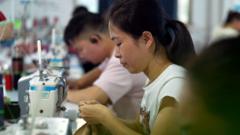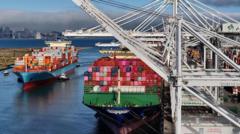An in-depth look at working conditions in Panyu, the heart of Shein's production, revealing long hours, low wages, and ongoing controversies
The Reality Behind Those Inexpensive Shein Outfits: An Investigation into Factory Conditions in China

The Reality Behind Those Inexpensive Shein Outfits: An Investigation into Factory Conditions in China
Exploring the dark side of fast fashion through the lens of Shein's supply chain in Guangzhou
The rhythmic sound of sewing machines fills the bustling streets of Panyu, Guangzhou, a key production hub for global fast fashion giant, Shein. Renowned as the “Shein village,” this neighborhood is home to thousands of factories churning out garments for consumers worldwide. A recent investigation highlights the labor conditions faced by workers who often clock in 75 hours a week, leaving them just one day off a month. The call for better treatment has gained momentum as Shein’s rapid growth, which has skyrocketed over the past five years, raises ethical questions about the exploitation of its workforce.
Owned privately and recently valued at $66 billion, Shein has become a dominant player in fast fashion, outshining billion-dollar brands like Zara and H&M. However, its reputation has been marred by allegations surrounding working conditions and forced labor. The company has faced scrutiny since it was discovered that child labor was present in its factories in China. Although Shein asserts its commitment to fair treatment and compliance in its supply chain, many factory workers tell a different story, revealing plummeting wages and backbreaking hours often spent in overcrowded conditions.
Interviewed factory owners and workers describe a stark reality where many earn as little as $1 on a garment, laboring tirelessly from dawn till late at night, trying to support families back home. The production model—driven by demand and the company's powerful algorithms—often leads to heightened pressure on factories to churn out clothing at rapid rates, frequently forcing them to hire temporary workers to meet swelling orders.
Labor activists and rights groups express grave concerns over the exploitation workers face, noting that many receive pay that fails to meet living wage standards established in China. Workers emphasize that these long hours and outdated practices violate basic human rights, with calls for better transparency and improved conditions in the fast fashion industry growing stronger.
Despite the criticisms, there are factory workers who acknowledge Shein's role in their economic livelihood, finding pride in contributing to a global industry. The competitive wages paid by Shein compared to local alternatives bolster its essential role in an economy where factory owners feel pressured to comply with the company’s demands or risk losing contracts.
Tensions continue to rise as Shein eyes a potential public listing, with experts arguing that the company must improve its practices or face repercussions in the court of public opinion. As both consumers and investors become increasingly aware of unethical practices that can hide behind trendy clothing and low prices, Shein and its suppliers are caught in a whirlwind of conflicting loyalties—between profitability and worker welfare, between swift production and ethical practices as they navigate the turbulent waters of global fashion.
Owned privately and recently valued at $66 billion, Shein has become a dominant player in fast fashion, outshining billion-dollar brands like Zara and H&M. However, its reputation has been marred by allegations surrounding working conditions and forced labor. The company has faced scrutiny since it was discovered that child labor was present in its factories in China. Although Shein asserts its commitment to fair treatment and compliance in its supply chain, many factory workers tell a different story, revealing plummeting wages and backbreaking hours often spent in overcrowded conditions.
Interviewed factory owners and workers describe a stark reality where many earn as little as $1 on a garment, laboring tirelessly from dawn till late at night, trying to support families back home. The production model—driven by demand and the company's powerful algorithms—often leads to heightened pressure on factories to churn out clothing at rapid rates, frequently forcing them to hire temporary workers to meet swelling orders.
Labor activists and rights groups express grave concerns over the exploitation workers face, noting that many receive pay that fails to meet living wage standards established in China. Workers emphasize that these long hours and outdated practices violate basic human rights, with calls for better transparency and improved conditions in the fast fashion industry growing stronger.
Despite the criticisms, there are factory workers who acknowledge Shein's role in their economic livelihood, finding pride in contributing to a global industry. The competitive wages paid by Shein compared to local alternatives bolster its essential role in an economy where factory owners feel pressured to comply with the company’s demands or risk losing contracts.
Tensions continue to rise as Shein eyes a potential public listing, with experts arguing that the company must improve its practices or face repercussions in the court of public opinion. As both consumers and investors become increasingly aware of unethical practices that can hide behind trendy clothing and low prices, Shein and its suppliers are caught in a whirlwind of conflicting loyalties—between profitability and worker welfare, between swift production and ethical practices as they navigate the turbulent waters of global fashion.



















